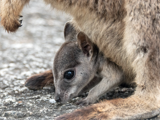Bilbies are currently being bred in several captive breeding facilities around Australia. One of these facilities is located at the Kanyana Wildlife Rehabilitation Centre. The Kanyana Bilby Breeding Program is conducted under the guidance of the WA Department of Parks and Wildlife (DPaW) and receives funding under DPaW’s Western Shield Program although the day to day running of the Kanyana Bilby Breeding Program is entirely volunteer run.
Many volunteers are involved in caring for the Kanyana bilbies. In any animal captive breeding program, it is important to maintain the greatest possible genetic diversity within the population. The bilbies in the Kanyana breeding program are paired according to recommendations made by the Bilby Studbook Keeper with the Zoo and Aquarium Association (ZAA).
The Studbook Keeper maintains the genetic records of all the bilbies in the captive breeding program and provides advice to all the bilby breeding facilities around Australia, and following advice from the Studbook Keeper, animals are regularly transferred between different captive breeding centres.



